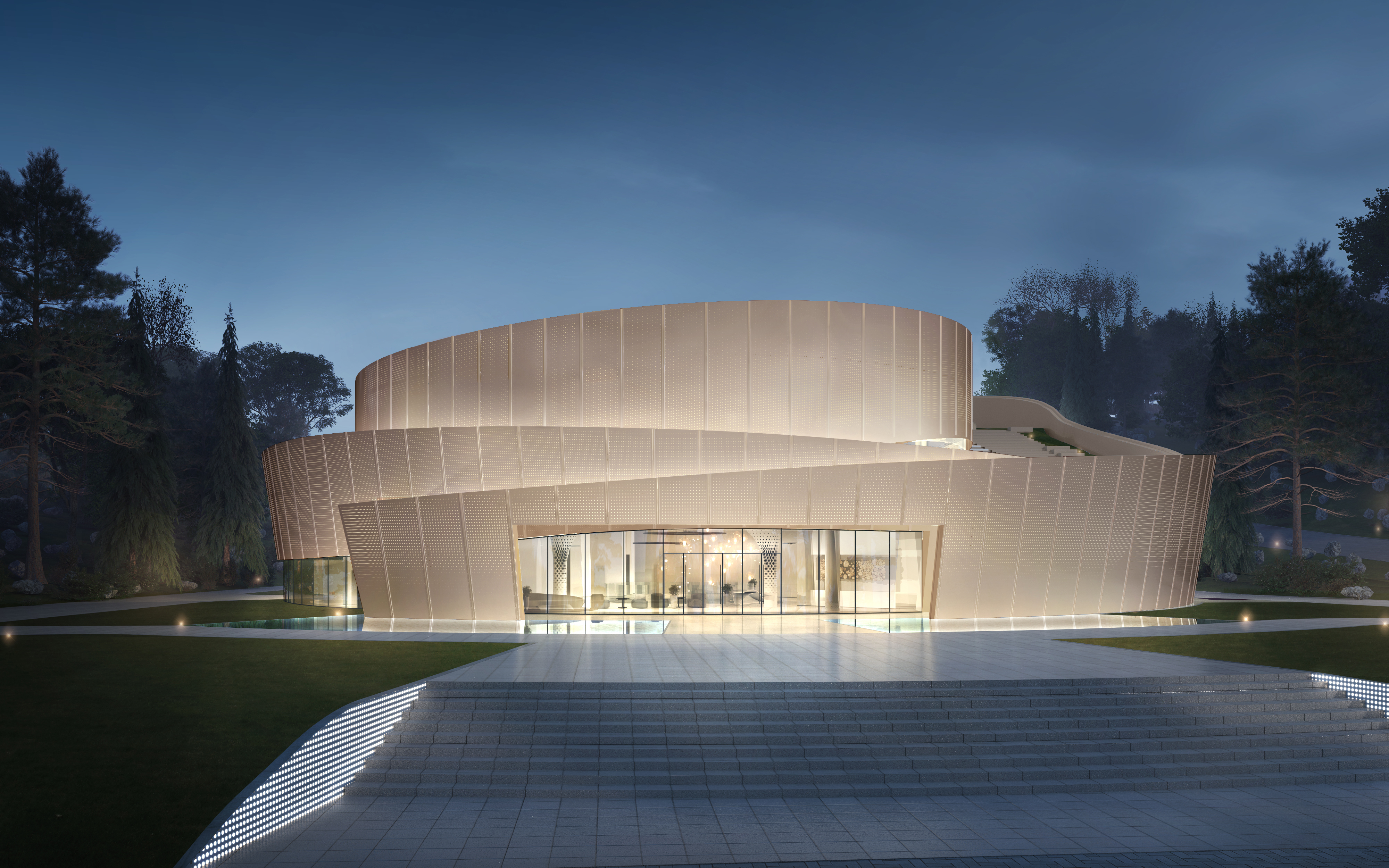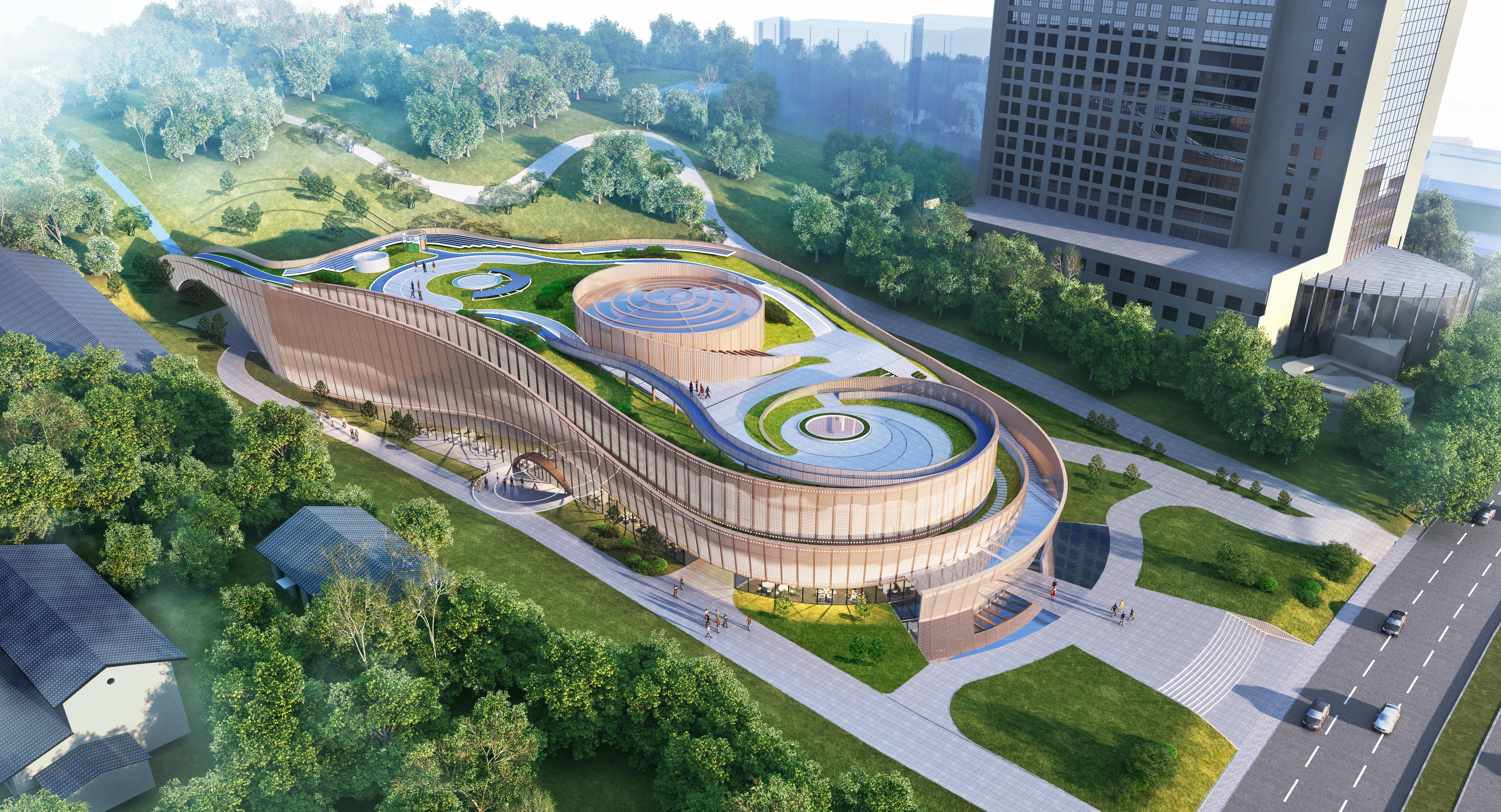All architectural renders of the The Lishui Photography Culture Center courtesy the Center
Investment in a vast new photography centre illustrates the scope of the city’s cultural reach, adding to China’s stature as a global photo destination
In October 2024, a huge new photography museum is due to open in Lishui, south-east China. The Lishui Photography Culture Center cost 309 million yuan (approximately £34.7million) to build over two years and will have a total construction area of 34,221 square metres, of which 15,150 square metres is devoted to three floors of exhibition space. By way of comparison, the V&A’s recently completed Photography Centre in London has 1000 square metres of dedicated space for photography, while New York’s Essex Crossing International Centre of Photography, opened in 2020, has just over 3700 square metres of exhibition, education and administration space.
With a population of 2.5 million, Lishui is small by Chinese standards – Beijing has 21.5 million citizens and Shanghai 26.3 million. But it was named the first ‘Hometown of Chinese Photography’ by the China Photographers Association in 1999 owing to the concentration of nationally renowned photographers in the area, and this inspired the Lishui Municipal People’s Government to set up the Lishui International Photography City 10-Year Development Plan. This led to the biennial Lishui Photography Festival, which launched in 2004, and to the more modest Lishui Photography Museum, which opened in 2007 as a place to exhibit, collect and study photography.

“Photography is closely intertwined with the development of technology,” Fu says. “Therefore, besides showcasing photographic art, the Center will also focus on the film and imaging industry, as well as technological advancements”
“Lishui aims to enhance its cultural landmark and international reputation by promoting the photography cultural brand,” says Weixin Fu, director of Lishui Photography Culture Center and the city’s Photography Museum, secretary general of the Theoretical Committee of Zhejiang Photographers Association, and a columnist for China Photography Daily and People’s Photography Daily. “Through the medium of photography, Lishui wishes to introduce itself to the world and encourage people to visit and appreciate this city. At the same time, Lishui aims to contribute to social and economic development as well as the growth of the visual industry through the art of photography.”
Fu is himself a photographer, specialising in photojournalism. But he has been involved with Lishui’s photography institutions since 2013, when he was appointed a key assistant of Wang Peiquan, the director of the China Photographers Association’s Curatorial Committee, and a key member of the Lishui Photography Festival Organising Committee. Fu has been actively involved in the planning and organisation of the Lishui Photography Museum and Lishui Photography Festival.
The 2023 festival was held in November. Themed ‘Images Gather Possibilities’, it included Chinese artists, such as Qingsong Wang, and image-makers from around the world, including big names such as Vivian Maier and Michael Wolf, plus emerging artists. Past festivals have had themes such as ‘Images in an Era of Hypermedia’, ‘Photography as Life’, ‘Integrate City Life into Nature’ and ‘New Start from Lishui’.
Since 2019, Lishui Photography Festival has collaborated in depth with the UK’s FORMAT Photography Festival, exchanging exhibitions and curatorial programming. In 2021, artist Lingfei Ren was selected to exhibit From That Day On at FORMAT in Derby, for example, while the exhibition un/natural, put together by the then-FORMAT curators Louise Fedotov-Clements and Niamh Treacy, introduced to China artists such as Federico Estol (Uruguay), Pietro Lo Casto (Thailand), Jakub Stanek (Poland) and Rosie Barnes (UK). Other external partners who have contributed exhibitions included Yale’s MFA Photography graduates and Photolucida’s Critical Mass initiative.
“In terms of exhibition planning for the Lishui Photography Festival, we invite professional curators to play a vital role, and we also participate in certain projects,” says Fu. “When selecting participating photographers, we consider several factors, such as the exhibition theme, content structure, artistic and topical qualities of the works themselves, as well as the individual identity of the photographers, taking a comprehensive approach.”

Deep pockets
Lishui Photography Museum has also established the Lishui International Photography Ranking, a new competition whose inaugural winner will receive an exhibition at the festival and a grant of 1 million yuan as artistic support (just over £112,000). Again by way of comparison, the award for the Deutsche Börse Photography Foundation Prize – one of the most generous in Europe – is £30,000. As with the Deutsche Börse Photography Foundation, a selection committee nominates photographers to compete for the Lishui award. But in this case, photographers can also apply for nomination themselves.
The judges are experts in various aspects of photography and come from all over the world. The 2023 panel featured Christopher Phillips, independent curator and former curator of New York’s International Center of Photography; Gu Zheng, an academic from Fudan University and art director of the Jimei × Arles International Photo Festival 2020–22; Peter Pfrunder, director and curator of Swiss Foundation for Photography; and Sujong Song, senior curator of the National Museum of Modern and Contemporary Art, Korea.
The existing Lishui Photography Museum is an important venue for the festival, and in future the event will move into the huge new centre. The building will obviously be a significant place to showcase photography in Lishui, says Fu, but it will also allow for more international partnerships. “Its completion is bound to bring more opportunities for cultural exchanges and collaborations in the field of photography,” he says. “In addition, we aspire to utilise this platform to introduce Lishui’s photography culture and the city to a larger global audience, hoping that it will be well-known and appreciated by people worldwide.”

Technological advancements
Fu also organises a photography symposium in Lishui, which runs alongside the festival. Running for the fifth time in 2023, the event focused on the relationship of AI technology and photography, drawing on “the rapid development of AI imaging recently, as well as the continuous redefinition and expansion of people’s understanding and perception of art due to advancements in artificial intelligence,” he says.
For Fu, engaging with technology is part of the mission, and he says the new centre will provide space to showcase and consider new developments. The 2023 festival, meanwhile, included awards for AI art for the first time. Fu also helped launch the first Photography Art Expo (or fair) in Lishui, which in 2022 attracted exhibitors from the imaging industry such as Huawei, Baidu, Philips and Adobe, but also games manufacturers.
“Photography is closely intertwined with the development of technology and the times,” Fu says. “Therefore, besides showcasing photographic art, the Photography Center will also focus on the film and imaging industry, as well as technological advancements.
“The centre should have a forward-looking perspective and provide a platform for displaying the film and imaging industry,” he continues. “Through the planning and organisation of events such as the World Photography Congress, Lishui Photography Festival, daily exhibitions and professional exchange activities, we hope to offer more opportunities for global exhibitions, collaborations and exchanges within the film and imaging industry. It would be very honourable for Lishui if this platform can contribute to the advancement of new imaging technologies.”
As Fu’s comments suggest, the photography projects in Lishui also have an eye for business, and another outlet is the emerging print market in Lishui and, more generally, in China. Fu says he “highly encourages” this market, adding: “Currently, the trading of photographic artworks is well-established internationally, but China started relatively later and primarily focused on first-tier cities. Lishui’s involvement in promoting the market for photographic artwork transactions aims to transform art into productivity, enabling more photographic artworks to enter the economic sphere and unleash their full potential value. This endeavour also serves as a positive incentive for artists in their creative pursuits.”

Chinese investment
A forward-thinking project with deep pockets, the Lishui Photography Culture Center looks set to firmly position photography in the city, and the city in the photography world. More widely, it helps cement China’s position as a hub for the medium. It is part of an ongoing wave of Chinese investment in the infrastructure around photography, which also includes initiatives such as the Lianzhou Museum of Photography. Drawing on the success of the Lianzhou Foto Festival, it opened in 2021.
It is fast progress from 2007, when photographers RongRong & inri set up China’s first contemporary art space dedicated exclusively to photography and lens-based art: the Three Shadows Photography Art Centre in Beijing. Three Shadows hooked up with Les Rencontres d’Arles, the world’s biggest photography festival, to launch Jimei × Arles in 2015, an annual festival held in the port city Xiamen. This year Jimei × Arles is hosting exhibitions by around 90 artists, including by 10 emerging Chinese image-makers selected for the Jimei × Arles Discovery Award. The winner is awarded an exhibition at the following Arles plus 100,000 Chinese yuan (just over £12,000).
Also in 2015, the Shanghai Center of Photography became the city’s first museum devoted to lens-based media. Set up by Pulitzer Prize-winning photographer Liu Heung Shing, it is part of an ambitious programme called Shanghai 2035, which aims to transform Shanghai into an international cultural hub through a slew of state funding and initiatives aimed at developing the design, film, performing arts, gaming and publishing industries. It has already helped attract international arts organisations to Shanghai, including the Centre Pompidou, which opened an outpost there in 2020.

